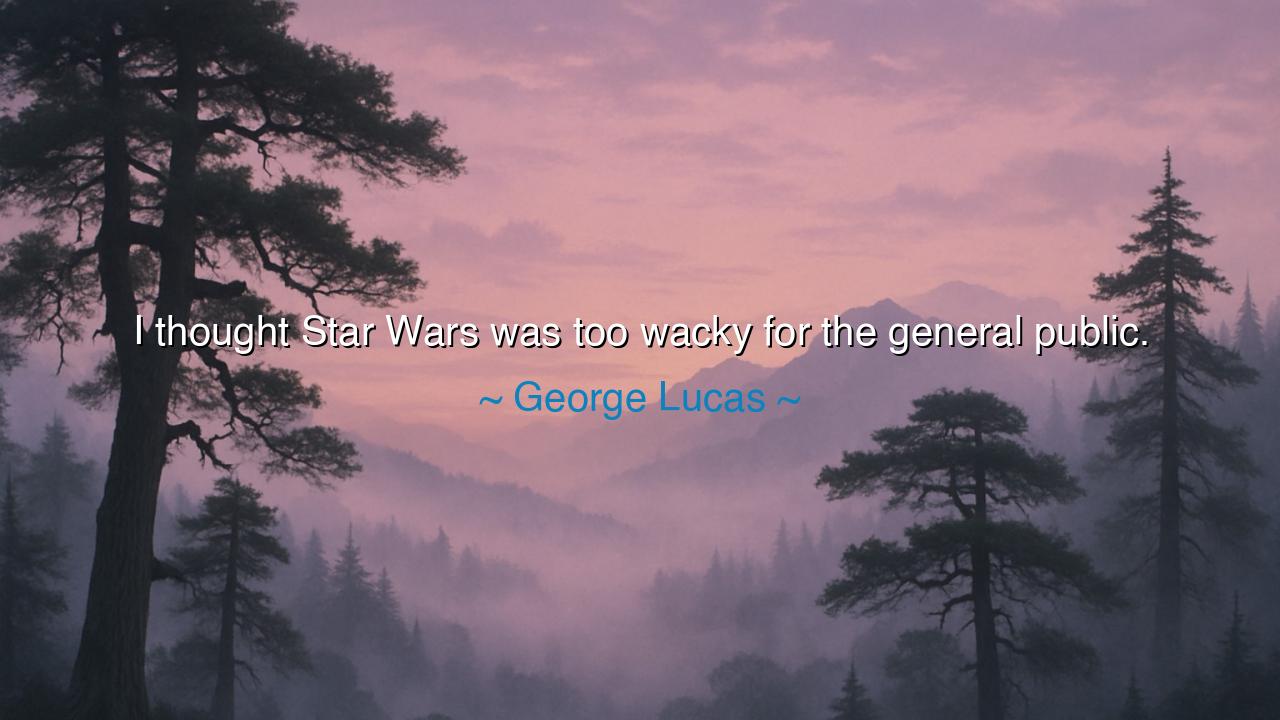
I thought Star Wars was too wacky for the general public.






When George Lucas confessed, “I thought Star Wars was too wacky for the general public,” he spoke the fear that haunts every creator who dares to dream beyond the boundaries of convention. His words reveal the trembling truth of originality: that what feels visionary to the artist often feels alien, even foolish, to the world. Lucas believed that his tale of Jedi knights, strange creatures, and distant galaxies might be dismissed as childish fantasy, too wild to be embraced. And yet, what he feared was “too wacky” became one of the most beloved sagas in human storytelling, proof that sometimes the boldest visions carry the deepest resonance.
The origin of this thought lies in the peril of imagination. Throughout history, those who sought to bring forth something new often doubted whether the world was ready. Lucas himself drew from myth, legend, and Joseph Campbell’s teachings on the hero’s journey, weaving timeless archetypes into futuristic space battles. To him, this blending of myth and spectacle seemed risky, uncertain, perhaps even absurd to the eyes of critics. But in truth, he was echoing the same rhythm of story that had guided humanity since the days of Homer and the epic poets. What he called “wacky” was in fact eternal.
Consider the story of Jules Verne, the great visionary of the nineteenth century. When he wrote of submarines, journeys to the moon, and great machines, many dismissed him as fanciful, too eccentric for the practical reader. And yet, his works inspired generations of dreamers and inventors, paving the way for realities that once seemed impossible. Like Lucas, Verne touched the ancient hunger of mankind: the longing to see beyond the horizon, to imagine worlds yet unseen. Both remind us that the greatest art often appears strange before it appears profound.
The meaning of Lucas’s words is also heroic: they reveal the humility of the artist in the face of his own creation. He did not stride forward with arrogance, convinced of his genius. Instead, he trembled as all true creators tremble, knowing that the fire they bring may either warm the world or be extinguished in ridicule. His doubt makes his triumph all the more extraordinary, for it shows that courage is not the absence of fear, but the resolve to create despite it.
The lesson here is timeless: do not cast aside your vision because it seems “too wacky” or unconventional. The world hungers not for repetition, but for wonder. The stories, inventions, and ideas that endure are not those that blend in, but those that dare to stand apart. What seems strange today may tomorrow be cherished as genius. Remember that the general public does not always know what it craves until it is shown. Lucas feared rejection, yet by giving his vision life, he opened the door to a universe that captured the imagination of millions.
What, then, should you do? First, honor the strange fire within you—the ideas, dreams, and visions that others may dismiss. Second, persist in creating, even when doubt whispers that no one will understand. Third, trust that what feels risky may in fact be the very thing that connects most deeply with the human soul, for originality often wears the disguise of absurdity until time reveals its power.
Thus, let George Lucas’s words echo across the generations: “I thought Star Wars was too wacky for the general public.” In this confession lies the eternal truth of creation—that the path of the dreamer is fraught with doubt, yet it is precisely this doubt that proves the courage of the act. And the teaching for all who listen is this: do not fear to be wacky, for in your strangeness may lie the seed of greatness.






AAdministratorAdministrator
Welcome, honored guests. Please leave a comment, we will respond soon